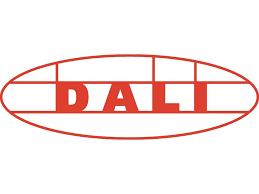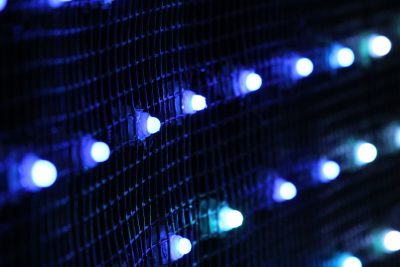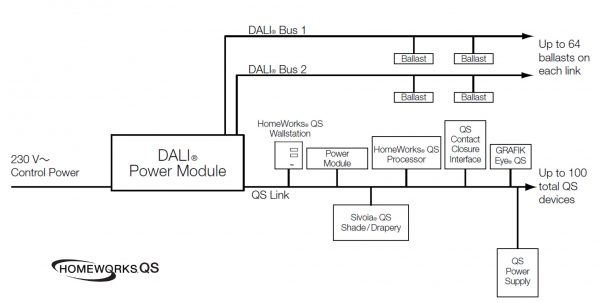If you want to know more about DALI – how it works and why it could right for your project – then read on. We’re going to dig deeper in the article below.
What is DALI?
DALI is a two-way digital communication protocol, developed to manage networked lighting-control systems used in building automation projects. A trademarked international standard, DALI enables smooth hassle-free integration of LED gear from diverse manufacturers – equipment that can include dimmable ballasts, receiver and relay modules, power supplies, dimmers/controllers and more.
Fully scalable and ideal for both simple and complex installations, the DALI protocol defines all the commands and communication channels that LED control devices need, in order to fully control building lighting.
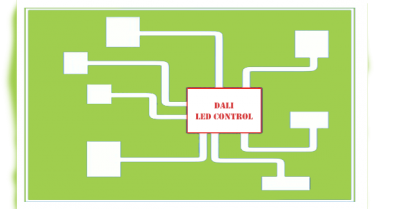
Why choose DALI?
If you’re a building designer, owner, electrician, facilities manager or an end-user, then DALI can provide your premises with powerful, adaptable digital lighting control. And you can be confident of no-fuss compatibility with current and future lighting gear from a huge range of suppliers.
For the simplest installations, e.g. single rooms or small buildings, a basic DALI system can be no more than multiple LED fittings connected to a DALI-compatible power supply through a single switch. This kind of set-up requires minimal configuration and eliminates the need for independent control circuits for each fixture.
Larger buildings, office complexes, retail premises, campuses and similar locations will benefit from DALI’s ability to individually address LED ballasts, power supplies and groups of devices, and to easily reconfigure those groupings whenever space and usage requirements change.
Here are some more reasons why choosing DALI control for your LEDs can be an excellent option:
- For facilities managers, the ability to monitor the status of each fixture and ballast is invaluable. Maintenance and replacement becomes far less time consuming.
- DALI is an open standard, so it’s easy to mix equipment from multiple suppliers and upgrade with new and improved kit when it hits the market.
- Central control and timer systems let you tailor lighting presets – great for convenience, peak demands, multi-scene venues and energy saving too.
- Because DALI uses very simple 2-wire connections, installation is surprisingly straightforward. You don’t require highly experienced installers, because there’s no need to know the final lighting configuration or to label and keep track of each fixture’s wiring. Just two cables, in and out, everywhere.
Before we go any further… just what do the letters ‘DALI’ actually mean, anyway?
DALI stands for Digital Addressable Lighting Interface. The technical specification is laid out in the International Electrotechnical Commission standard IEC 62386 (in conjunction with IEC 60929, an electronic ballasts standard).
Beginning in the middle 1980’s, development of the DALI protocol was initiated by a collection of European ballast suppliers that included Philips. American companies in the field joined the programme later, in the 1990’s. The first international DALI standard was accepted and published in 2002.
How do you control DALI?
While most of the lighting fixtures used within DALI installations are the same as those used by other lighting control systems, the ballasts, receiver modules and drivers are a different story. These specialised units enable DALI’s highly configurable 2-way digital communications, and can be linked to a central control system – which may be as simple as a laptop or as powerful as a dedicated lighting control desk.
Fixed light switches can be configured centrally, to manage an individual light source or a group of lights (aka a lighting zone). When the switch is flipped (or dimmed), the instruction is sent to all light fixtures that are configured to be in the same ‘group’.
A simple DALI system (sometimes called a loop) can manage a maximum of 64 LED ballasts and power supplies. Each device has its own address, all connected back to the central DALI controller. To manage lighting for a larger location, multiple loops are typically linked and controlled together.
What is a DALI bus?
DALI systems use a 2-wire bus to communicate instructions and status data between the installation’s control gear, slave devices and bus power supplies.
- Control gear is the hardware that provides LED power, which in turn controls the light being output from your LEDs.
- Slave devices (aka ‘control devices’) include both the input devices we use to adjust lighting (e.g. light switches, lighting control desks etc), and the application controllers that interpret input and transmit the necessary instructions to adjust power to the appropriate LED.
- Bus power supplies are required because the DALI bus must be powered for instructions to be sent and received (typically using round 16V when there is no communication, more when instructions are being communicated).
The current DALI standard includes strict interoperability requirements, which means that certified products from different manufacturers to be used together on the same DALI bus.
A single DALI bus can manage 64 control gear addresses and 64 addresses for control devices. Larger systems combine multiple buses to form a ‘network of networks’.
What is a DALI controller?
There are a wide range of control options to manage your LEDs via DALI. Centralised control systems, smart-home automation, laptop apps, and manual wall-mounted and remote controllers are all available, as are passive controllers such as timers and photosensors.
Call us on 0116 2799 083 to discuss your project’s DALI controller requirements.
What is a DALI receiver?
Linked to a DALI controller and a suitably-powered power supply, a certified DALI dimming receiver unit provides the control your LED project requires.
To find out more about DALI control, why not explore our support pages on white / single-colour dimming and RGB colour control? And if you’re looking for a simple controller for your DALI installation, check out InStyle’s single-zone wall mounted DALI dimmer (or scroll down for more information).
How do you wire a DALI LED control system?
Can I control other lighting using the same DALI controller – for example, LED lights and other things?
Yes… as long as all devices are certified to the current DALI standard.
Can DALI work with home automation systems such as Lutron and KNX?
Yes it can. While most home automation systems offer comparable functionality to DALI, there are nonetheless some potential benefits to be gained by integrating the two control protocols together:
- Price – DALI products can be less expensive.
- Control gear options – DALI may offer a wider range of input devices.
- Flexible configuration – it may be easier to reconfigure lighting zones and scenes using DALI, when you need to do so.
- Wiring & installation – DALI’s 2-wire communication may be more straightforward to fit than many corresponding home automation systems’ wiring.
What DALI control products do InStyle LED offer?
Depending on the number of zones to be independently controlled, you can select either a single-channel (8 amps) or 4-channel DALI receiver (4 x 5 amps). Input voltage is 100-240v AC.
InStyle LED’s 1-channel and 4-channel DALI receivers are both fully compatible with standard DALI protocol.
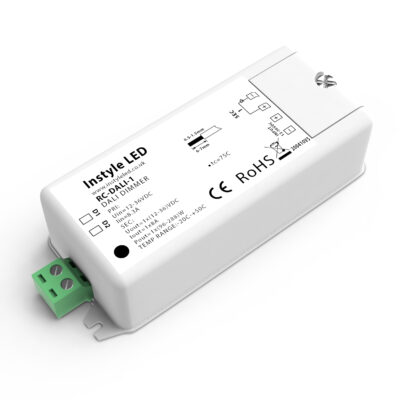
Our single-channel DALI receiver is ideal for white / single-colour LED strip lighting (either 12V or 24V). It outputs a maxium of 8 amps.

The 4-channel DALI receiver by InStyle can be used to control our colour-change LED strips, including RGBW / RGB / dual-white LEDs. It outputs up to 4 x 5amp, and works with 12V or 24V lighting.
How many metres of LED strip can I run off a DALI 8amp or DALI 4 x 5amp receiver?
| Product to be controlled | 1x8amp – LED tape max length | 4x5amp – LED tape max length |
|---|---|---|
| 12v, 5 watt White LED Tape | 19.2 metres | 12 metres |
| 12v, 7.5 watt RGB LED Tape | — | 24 metres |
| 12v, 10 watt White / RGBW LED Tape | 9.6 metres / — | 6 metres / 24 metres |
| 24v, 12 watt White / Dual-White LED Tape | 16 metres / — | 10 metres / 20 metres |
| 24v, 15 watt Single-Colour / RGB LED Tape | 12.8 metres / — | 8 metres / 24 metres |
| 24v, 20 watt White / RGBW LED Tape | 9.6 metres / — | 6 metres / 24 metres |
| 24v 24 watt White / Dual-White LED Tape | 8 metres / — | 5 metres / 10 metres |
…Or why not try our LED receiver output calculator to find how much LED tape your receiver can drive?


